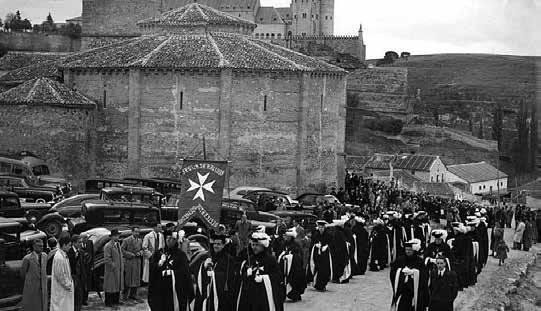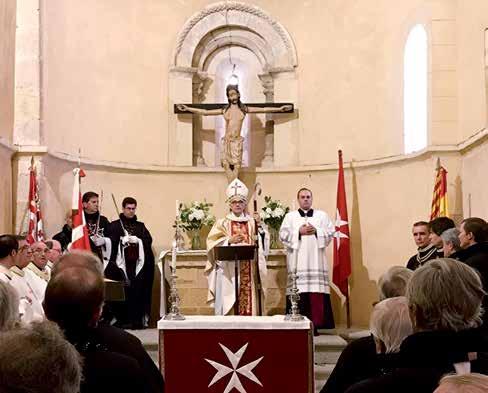
5 minute read
The True Cross
THE
TRUE CROSS

For the past 800 years, Church of the True Cross, considered one of the best preserved of its kind in Europe, has stood as a shrine to the Vera Cruz and the people of Segovia.
It’s Good Friday at the Iglesia de la Vera Cruz, or the Church of the True Cross, in the San Marcos district of Spain, just north of the city of Segovia. The Knights and Dames of the Order gather in their robes, carrying out their sacred celebration of Lignum Crucis.
The procession passes the tombstone at the side door of the temple. The Knights and Dames are guided by an inscription on a tomb, dated 13 September 1208: “Let the founders of this temple be placed in the heavenly seat, and let those who have gone astray accompany them there.”
The procession passes the exterior walls made of finely dressed stone, entering the temple, built in a Romanesque style, transcending into Gothic. They pass an opening to a small semicircular arrow window that gives light to the temple. The members enter the circular nave (the inner temple), with its 12-sided polygon floor plan, surrounding a central two-story chamber.
The portrait of the Patroness of the Order Our Lady of Philermos looks over the procession, next to the Order’s Patron Saint John the Baptist.
The Order’s old and new flags fly proudly in the temple. • The State flag of the Sovereign Order of Malta and flag of Saint
John and the original eight Langues of the Order • Langue of Auvergne • Langue of Italy





• Langue of Castilla y León • Langue of Germany • Langue of Aragon and Navarra • Langue of France • Langue of Provence • Langue of Anglo-Bavaria
The Church is said to have been built in 1208, based on the shape of Jerusalem’s Church of the Holy Sepulchre by the Knights Templar. According to legend, the True Cross, the Vera Cruz, on which Jesus Christ was crucified, was found by St. Helena in the 4th century. The lignum crucis or the wood of the True Cross, was kept in a niche in the chapel of the tower until it was removed to the nearby village Church of Zamarramala, where it can be admired only at Easter.
After the dissolution of the Templars, the Knight’s assets were to pass to the Order of Saint John of Jerusalem according to the Papal provision of 1317. But there were a series of assets that by royal compromise did not reach the hands of the Order. Specifically, the Church of Vera Cruz, which went on to increase the assets of the Order of Canons who guarded the Holy Sepulcher in Jerusalem, together with the Zamarramala commission and others in Zamora.
A little less than a century and a half later, Pope Innocent VIII suppressed the Order of the Canons Regular of the Holy Sepulchre in the bull of March 28, 1489, arranging for its assets to pass to
the Order of Saint John, although the definitive incorporation did not take place until 1531.
The building, despite a few additions, remains in much the same state as the time of its construction thanks to the incredible preservation work made on this historic church. It’s considered one of the bestpreserved churches of this style in Europe, and was declared a Spanish Property of Cultural Interest on 4 July 1919 by H.M. the King D. Alfonso.
After several decades the Church of the Vera Cruz was donated in perpetuity to the Order of Malta after the necessary restoration in 1951.
Inside the Church, valuable paintings are found on the walls of the polygonal design.
A gothic-renaissance altar piece dates to 1516, and a stone tablet can be found in the central building where the Knights must have carried out the Vigil of their Arms.
The octagonal edicule is said to be based on the Church of the Holy Sepulchre. It has three semicircular chapels, two doorways with archivolts on columns, and a tower on the south side, which can be climbed for an impressive view of the Alcázar surrounds and the old city.
Someone who saw the beauty in the Church of the True Cross was Dublin-based painter Philip Harewood, who painted a portrait of the church in 1999.
The long-time painter and retired bank official spent his holidays travelling and drawing, mostly churches, but never sold one of his paintings. Phillip was fascinated in the work of the Order of Malta and so beautifully captured the Church of the True Cross’s charm with the Alcázar of Segovia in


the background (see image above).
In 2018, a Dame of the Order and Philip’s cousin Mrs Deirdre Page DMG (Ob), kindly donated a print of the original painting of the Church of the True Cross.
In his letter to the Australian Order of Malta, Philip said he would be “honoured” if this donation was met with the approval of the Order, to which it was.
“It’s a wonderful depiction of the church,” Dame Deirdre says. “It’s a moment captured in time, and such a sacred treasure for the Order, given it is the oldest chapel the Order owns.”
Left: Valuable paintings are found on the walls of the polygonal design of the Church, in addition to a gothic-renaissance altar piece dating back to 1516.
Top: A print of Philip Harewood’s artwork of the True Cross church, said to have been built as early as the 13th century; Mrs Deirdre Page DMG (Ob) presented the original painting to the Australian Order of Malta in 2019.










